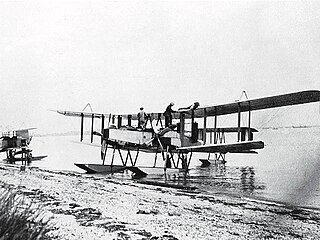
The Fairey Aviation Company Fairey III was a family of British reconnaissance biplanes that enjoyed a very long production and service history in both landplane and seaplane variants. First flying on 14 September 1917, examples were still in use during the Second World War.

The Short Bomber was a British two-seat long-range reconnaissance, bombing and torpedo-carrying aircraft designed by Short Brothers as a land-based development of the very successful Short Type 184.
The Aichi AB-1 was a result of a 1926 government call for a small, Japanese-built, civil transport biplane able to operate from land or water. It won the contest in both roles but did not reach production as airlines moved from biplanes to monoplanes. Nonetheless, it remained in commercial use well into the 1930s.

The Blackburn T.R.1 Sprat was a British single-engine two-seat biplane trainer, built in 1926 for advanced training, deck-landing and seaplane experience. Just one was built.

The Blackburn B.T.1 Beagle was a British single-engine, two-seat biplane bomber/torpedo aircraft from 1928. Designed to Air Ministry specifications which led to no contracts for any manufacturer, only one Beagle was built.

The Gloster Goring was a single-engined two-seat biplane designed to meet 1926 Air Ministry specifications for a day/torpedo bomber. It was not put into production and the one aircraft built served later as an engine testbed.
The Latécoère 550 was a four-engined French seaplane, designed in the early 1930s as a bomber/torpedo bomber. Though initial handling problems were partly resolved, the aircraft was deemed too slow and did not go into production.

The Fokker D.IX was a Dutch single seat, single engine fighter aircraft, the final, more powerful evolution of the Fokker D.VII World War I success, flown in 1921. The sole example was purchased by the US Army Air Service but not developed further.

The Curtiss CT-1 model 24, a twin engine torpedo bomber mounted on floats, was first flown in 1921.

The Blackburn G.P seaplane,, was a British twin-engine reconnaissance torpedo floatplane of the First World War, built by the Blackburn Aeroplane and Motor Co Ltd.

The CANSA FC.12 was a single engine monoplane ground attack aircraft developed in Italy around 1940. A crew of two were seated in tandem. Only ten production aircraft were built.

The Pander P-1 and P-2 were close to-identical single engine Dutch sports aircraft with tandem seats and a parasol wing, first flying in 1929. Only two were built.
The NVI F.K.29 was a small Dutch biplane transport, carrying two passengers who boarded after the nose, with its single engine and fuselage, had been swung open. It was intended to link small local fields to main airports.

The NVI F.K.34 was a three-seat reconnaissance seaplane built in the Netherlands in 1925 as a private venture in the hope of a Dutch Naval Aviation Service order; two accidents during testing meant that it did not go into production.

The Fokker D.XII was a Dutch single seat, single engine fighter aircraft designed to an American specification which called for the use of a Curtiss D-12 engine, designated PW-7. Despite considerable efforts to improve the airframe, Fokker failed to win the USAAS competition.

The Fokker T.II or T.2 was a single engine floatplane designed in the Netherlands in the early 1920s as a torpedo bomber. Three were bought by the US Navy who tested them against other aircraft from the US and the UK. The T.IIs did not win further production orders but remained in service for several years.
The Kondor E 3, sometimes erroneously known as E.III, was a German single seat, monoplane fighter aircraft designed and built close to the end of World War I. Though successful in the third D-type fighter competition at Aldershof in September 1918, only a few were produced, given the Idflieg designation of Kondor D.I.

The Nieuport-Delage NiD 43 was a single engine, two seat biplane fighter aircraft designed and built for shipboard use in France in 1924.

The Payen Arbalète was a small, pusher configuration, experimental French tailless aircraft first flown in 1965.

The CAMS 52 was a twin-engined floatplane torpedo-bomber. It was not ordered by the French Navy and only one CAMS 52 was completed. It first flew in the summer of 1930.
















